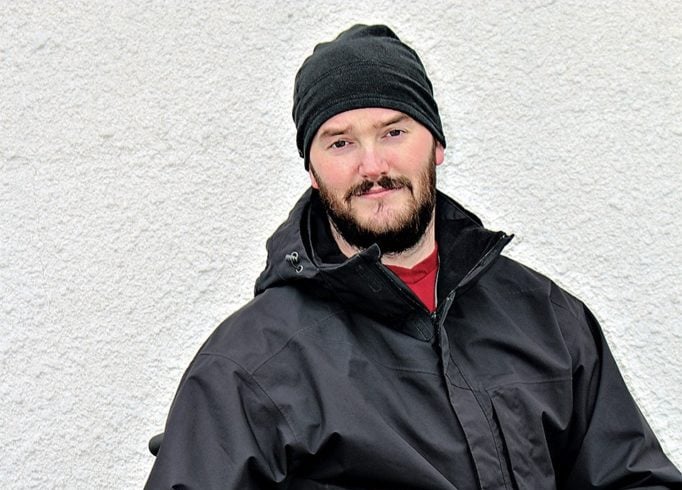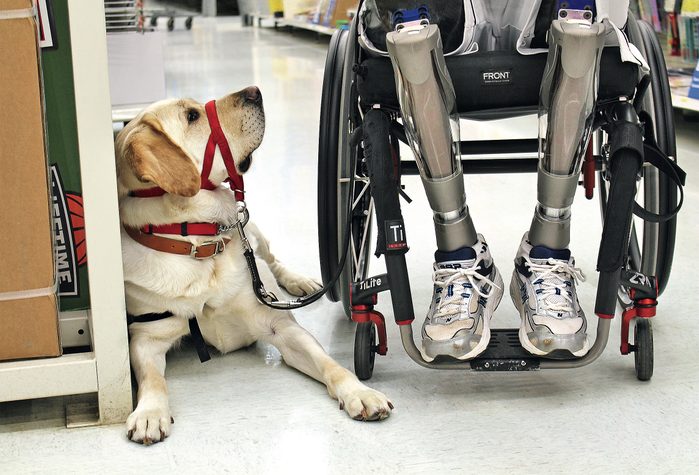
William Goodwin grew up in Thompson, Man., and moved to Ontario when he was 20. A year later he joined the military, becoming Cpl. Goodwin of the 1st Battalion, The Royal Canadian Regiment, stationed at Canadian Forces Base Petawawa.
The Royal Canadian Regiment was formed as the Infantry School Corps in 1883. Since that date, the regiment has been involved in nearly every conflict and operation involving the deployment of Canadian Forces units or personnel.
William was wounded while serving in Afghanistan. Despite the challenges involved with his long recovery, he has made enormous progress and his spirits are high. He is now paired with Vantage, from the Assistance Dogs Division of Canadian Guide Dogs for the Blind.
William says, “A couple of months after my injury, my occupational therapist suggested that I might be eligible for an assistance dog. I was immediately interested, but I had just started physiotherapy and learning to walk on prosthetics. I felt it was not the right time. It was about a year later that I sent in the paperwork.”
Shortly thereafter, William met with a trainer from Canadian Guide Dogs for the Blind’s Assistance Dogs Division, and he was introduced to a couple of dogs. He still felt uncertain about how much he would be walking, so he decided to wait until this was a little clearer. The training started about a year later, when William could work on handling a dog from both the wheelchair and in a standing position. His walking was still very unstable, but he started with the chair and adjusted to the legs as he could.
“The training was extremely educational, learning how a dog’s mind works and all the different commands he is capable of,” says William. He received Vantage on the second day of training and the dog was permitted to stay at William’s home from that point, as he continued the training course. William was advised that it could take from three to six months before Vantage would bond with him. He says, even knowing what to expect, he questioned whether he had made a mistake.

“It was probably in the fourth month that I really started to notice Vantage was bonding to me and that was a pretty incredible feeling. In my day-to-day activities, Vantage is capable of doing all sorts of tasks, but the biggest help he can give me is also the simplest – picking things up for me and just being around, drawing my attention enough to help with any anxiety I might be having. It is almost guaranteed that I will drop something when I am walking as I try to juggle my two canes, wallet and phone.”
William adds, “It has gotten to the point that I don’t even have to say anything. If Vantage sees me drop something, he immediately retrieves it for me. It makes me smile every time.”
William tries to encourage people as much as he can when they ask about an assistance dog.
“I usually tell people how difficult the first few months can feel. I never had a pet before, so it kind of caught me off guard just how much work is involved. It is tough to describe just how incredible having Vantage in my life is. He gives me a reason to wake up every morning and keeps me smiling throughout the day. He also forces me to get outside and be more active.”
While there are dogs that are used to assist individuals suffering from long-term post traumatic stress disorder (PTSD), it is important to note that Vantage is used to assist with mobility issues, as are all dogs in the Assistance Dogs Division of Canadian Guide Dogs for the Blind. While there may be some unintentional overlap, such as Vantage providing William with a caring companion and the responsibility of having a dog to care for, the main intention is for Vantage to assist Goodwin with mobility and tasks that he cannot perform himself. Canadian Guide Dogs for the Blind does not train dogs for PTSD; however, the Assistance Dogs Division continues to assist individuals with mobility-related disabilities within a 200-kilometre radius of Ottawa, within Canada.
And there’s no doubt that both William and Vantage are very happy about that fact.